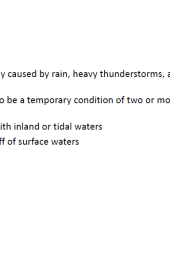Floods
Summary
The presentation covers various aspects of floods, including their classification, causes, methods for determining flood flow, techniques for estimating floods, and the calculation of flood design. Additionally, it addresses the measurement of discharge related to floods.
A flood is typically triggered by various natural phenomena such as intense rainfall, heavy thunderstorms, and the melting of snow, leading to an overflow of water beyond the capacity of normal drainage systems. This natural disaster results in the temporary inundation of large expanses, typically two or more acres, of previously dry land. Floods can be triggered by the overflow of inland or tidal waters, as well as the rapid runoff of surface waters. Additionally, mudflows, characterized by the movement of water-saturated earth and debris, contribute to the destructive impact of floods. The consequences of floods include widespread damage to property, displacement of populations, and disruption of communities, underscoring the importance of effective disaster preparedness and management strategies to mitigate the impact of these events.
Categories:
Presentations
Published Year:
2020
